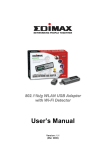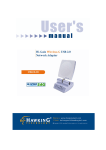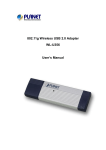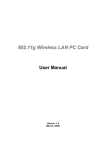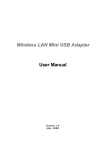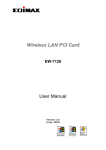Download Intellinet Wireless G USB Adapter
Transcript
802.11g Wireless LAN Mini USB Adapter User Manual Version: 2.0 (August, 2004) COPYRIGHT Copyright © 2004/2005 by this company. All rights reserved. No part of this publication may be reproduced, transmitted, transcribed, stored in a retrieval system, or translated into any language or computer language, in any form or by any means, electronic, mechanical, magnetic, optical, chemical, manual or otherwise, without the prior written permission of this company This company makes no representations or warranties, either expressed or implied, with respect to the contents hereof and specifically disclaims any warranties, merchantability or fitness for any particular purpose. Any software described in this manual is sold or licensed "as is". Should the programs prove defective following their purchase, the buyer (and not this company, its distributor, or its dealer) assumes the entire cost of all necessary servicing, repair, and any incidental or consequential damages resulting from any defect in the software. Further, this company reserves the right to revise this publication and to make changes from time to time in the contents hereof without obligation to notify any person of such revision or changes. All brand and product names mentioned in this manual are trademarks and/or registered trademarks of their respective holders. Federal Communication Commission Interference Statement This equipment has been tested and found to comply with the limits for a Class B digital device, pursuant to Part 15 of FCC Rules. These limits are designed to provide reasonable protection against harmful interference in a residential installation. This equipment generates, uses, and can radiate radio frequency energy and, if not installed and used in accordance with the instructions, may cause harmful interference to radio communications. However, there is no guarantee that interference will not occur in a particular installation. If this equipment does cause harmful interference to radio or television reception, which can be determined by turning the equipment off and on, the user is encouraged to try to correct the interference by one or more of the following measures: 1. Reorient or relocate the receiving antenna. 2. Increase the separation between the equipment and receiver. 3. Connect the equipment into an outlet on a circuit different from that to which the receiver is connected. 4. Consult the dealer or an experienced radio technician for help. FCC Caution This equipment must be installed and operated in accordance with provided instructions and a minimum 5 cm spacing must be provided between computer mounted antenna and person’s body (excluding extremities of hands, wrist and feet) during wireless modes of operation. This device complies with Part 15 of the FCC Rules. Operation is subject to the following two conditions: (1) this device may not cause harmful interference, and (2) this device must accept any interference received, including interference that may cause undesired operation. Any changes or modifications not expressly approved by the party responsible for compliance could void the authority to operate equipment. Federal Communication Commission (FCC) Radiation Exposure Statement This equipment complies with FCC radiation exposure set forth for an uncontrolled environment. In order to avoid the possibility of exceeding the FCC radio frequency exposure limits, human proximity to the antenna shall not be less than 20cm (8 inches) during normal operation. R&TTE Compliance Statement This equipment complies with all the requirements of DIRECTIVE 1999/5/CE OF THE EUROPEAN PARLIAMENT AND THE COUNCIL of March 9, 1999 on radio equipment and telecommunication terminal Equipment and the mutual recognition of their conformity (R&TTE) The R&TTE Directive repeals and replaces in the directive 98/13/EEC (Telecommunications Terminal Equipment and Satellite Earth Station Equipment) As of April 8, 2000. Safety This equipment is designed with the utmost care for the safety of those who install and use it. However, special attention must be paid to the dangers of electric shock and static electricity when working with electrical equipment. All guidelines of this and of the computer manufacture must therefore be allowed at all times to ensure the safe use of the equipment. EU Countries Intended for Use The ETSI version of this device is intended for home and office use in Austria, Belgium, Denmark, Finland, France, Germany, Greece, Ireland, Italy, Luxembourg, the Netherlands, Portugal, Spain, Sweden, and the United Kingdom. The ETSI version of this device is also authorized for use in EFTA member states: Iceland, Liechtenstein, Norway, and Switzerland. EU Countries Not intended for use None. CONTENTS 1 INTRODUCTION ............................................................................. 1 1.1 F EATURES .................................................................................................... 1 1.2 S PECIFICATIONS ............................................................................................ 1 1.3 P ACKAGE C ONTENTS ..................................................................................... 2 2 INSTALLATION PROCEDURE ..................................................... 3 3 CONFIGURATION UTILITY ......................................................... 9 3.1 W IRELESS C ONNECTION S TATUS .................................................................... 9 3.2 G ENERAL C ONNECTION S ETTING ................................................................. 11 3.3 WEP AND WPA E NCRYPTION ...................................................................... 14 3.3.1 WEP Setting ........................................................................................................... 15 3.3.2 WPA Setting .......................................................................................................... 16 3.4 A DVANCED S ETTING ................................................................................... 18 3.5 S OFTWARE AP M ODE .................................................................................. 19 3.5.1 AP Connection Status ............................................................................................. 19 3.5.2 AP General Connection Setting ............................................................................... 20 3.5.3 MAC Address Filter................................................................................................ 22 4 TROUBLESHOOTING .................................................................. 24 1 Introduction Thank you for purchasing the 802.11g W ireless LAN Mini USB Adapter. This USB Adapter is designed to comply with IEEE 802.11g W ireless LAN standard and easy to carry with the Mini size. It is suitable for any Laptop or Desktop computers. This adapter supports 64/128/256-bit W EP data encryption that protects your wireless network from eavesdropping. It also supports WPA (Wi-Fi Protected Access) feature that combines IEEE 802.1x and TKIP (Temporal Key Integrity Protocol) technologies. Client users are required to authorize before accessing to APs or AP Routers, and the data transmitted in the network is encrypted/decrypted by a dynamically changed secret key. This adapter has built-in AES engine which ensure the highest degree of security and authenticity for digital information and it is the most advanced solution defined by IEEE 802.11i for the security in the wireless network. This adapter is cost-effective, together with the versatile features; it is the best solution for you to build your wireless network. 1.1 Features • • • • • • • • • 1.2 Complies with the IEEE 802.11b and IEEE 802.11g 2.4GHz standards. Up to 54Mbps high data transfer rate. Support 64/128/256-bit WEP, WPA (TKIP with IEEE 802.1x) and AES functions for high level of security. Supports Software AP function, which turns the wireless station into a wireless AP. Complies with IEEE 802.11d country roaming standard. Support the most popular operating system: Windows 98SE/Me/2000/XP/Server 2003. Supports USB 2.0/1.1/1.0 interface. Portable and mini-size design. Suitable for Any Notebook or Desktop PC. Specifications • • • • Standard: IEEE 802.11g/b Bus Type: USB 2.0 Type A Frequency Band: 2.4000~2.4835GHz (Industrial Scientific Medical Band) Modulation: OFDM with BPSK, QPSK, 16QAM, 64QAM (11g) BPSK, QPSK, CCK (11b) • • • • • Data Rate: 54/48/36/24/18/12/11/9/6/5.5/2/1Mbps auto fallback Security: 64/128/256-bit WEP Data Encryption, WPA (IEEE 802.1x with TKIP) and AES Antenna: Internal Antenna Drivers: Windows 98SE/Me/2000/XP/Server 2003 LED: Link/Activity 1 • • • • • 1.3 Transmit Power: 16dBm (Typical) Dimension: 9(H) x 27(W) x 87(D) Temperature: 32~131°F (0 ~55°C) Humidity: 0-95% (NonCondensing) Certification: FCC, CE Package Contents Before you begin the installation, please check the items of your package. The package should include the following items: • • • • One USB Adapter One USB 2.0 Extension Cable (100 cm) One Quick Guide One CD (Driver/Utility/Manual) If any of the above items is missing, contact your supplier as soon as possible. 2 2 Installation Procedure Before you proceed with the installation, please notice following descriptions. Note1: Please do not install the USB adapter into your computer before installing the software program from the CD. Note2: The following installation was operated in Windows XP. (Procedures are similar for Windows 98SE/Me/2000/Server 2003.) Note3: If you have installed the Wireless PC Card driver & utility before, please uninstall the old version first. Please follow below instructions to install the USB Adapter. I. Install the Configuration Utility A. Insert the Installation CD to your CD-ROM Drive. Execute the “setup” program. B. If you want to install the software program in another location, click “Browser” and select an alternative destination. Then, click “Next”. 3 C. Click “Continue Anyway” to finish the installation. 4 D. Click “Finish” to complete the installation. II. Install the USB Adapter A. Plug the USB Adapter into the USB port of your computer. B. The “Found New Hardware Wizard” is displayed, select “Install the software automatically (Recommended)” and click “Next”. C. Click “Continue Anyway” and the system will start to install the USB adapter. 5 D. Click “Finish” to complete the installation. 6 III. Using the Configuration Utility To setup the USB adapter, double-click the icon in the system tray. For Windows XP, there is a “Windows Zero Configuration Tool” for you to setup wireless clients. If you want to use the Utility of the USB adapter, please follow one of the ways as below. First Way A. Double-click the utility icon in the system tray. B. Click “Yes” to use the utility of the USB adapter. Second Way A. Right-click the icon and select “View Available Wireless Networks”. B. Click “Advanced”. C. Uncheck “Use W indows to configure my wireless network settings”. 7 8 3 Configuration Utility The Configuration Utility is a powerful application that helps you configure the 802.11g Wireless LAN Mini USB Adapter and monitor the link status during the communication process. The Configuration Utility appears as an icon on the system tray of W indows while the card is running. You can open it by double-click on the icon. Right click the icon, there are some items for you to operate the configuration utility. Open Utility W indow Select “Open Utility Window” to open the Configuration Utility tool. Exit ZDW lan Select “Exit ZDW lan” to close the Configuration Utility tool. Before using the utility, you have to know some restrictions of the utility. 1. If you want to connect to 11g (up to 54Mbps) network, please ensure to install the adapter to PC or laptop with USB 2.0 interface. This adapter runs at lower performance while you connect it to the USB 1.1/1.0 port of your computer instead. 2. This adapter will work in 11b mode when the network type is in Ad Hoc mode. It is defines by Wi-Fi organization. If you want to enable the data rate up to 54Mbps (11g), please follow steps listed below. A. Go to “Network Connections”. B. Right Click the “Wireless Network Connection” and select “Properties”. C. From the pop-up screen, click “Configure”. D. Enter into “Advanced” page of the “Properties” screen. E. Enable the setting of “IBSS_G_Mode”. 3.1 Wireless Connection Status When you open the Configuration Utility, the system will scan all the channels to find all the access points/stations within the accessible range of your card and automatically connect to the wireless device with the highest signal strength. From the screen, you may know all the information about the wireless connection. 9 Parameter Description Mode Station – Set the USB adapter a wireless client. Access Point – Turns the USB adapter to function as a wireless AP. Please refer to Section 3.5 for the AP settings. Network Adapter Display the product information of the USB Adapter. Available Network Display all the SSID and Signal Strength of wireless devices nearby. To re-survey the available wireless devices please click “Refresh”. There are two ways to automatically make the connection between the USB Adapter and the wireless device on the list. 1. Double-click the wireless device on the list directly. 2. Select the device you intend to connect and then click “Connect this site“. Current Network Information Display the information about the wireless network this adapter is connecting to. The information includes Channel, Type, SSID, TX Rate and Encrypt settings. Note: Please refer to Section 3.2 for the description of each item. More Setting For setting more functions including disable/enable W EP and Power Saving Mode, etc. Please refer to Section 3.2, 3.3 and 3.4. Link Status Display the status of the wireless connection. BSSID Display the MAC Address of the network the adapter is connecting to. 10 Parameter Description Signal Strength This bar shows the signal strength level. The higher percentage shown in the bar, the more radio signal been received by the adapter. This indicator helps to find the proper position of the adapter for quality network operation. Link Quality This bar indicates the quality of the link. The higher the percentage, the better the quality. TX Frame It shows the number of data frames which are transmitted by the adapter successfully. RX Frame It shows the number of data frames which are received by the adapter successfully. 3.2 General Connection Setting Click “More Setting”, users are allowed to setup the wireless connection setting, Encryption Setting of the USB adapter and other advanced functions. 11 Parameter Description General Connection Setting Channel Select the number of the radio channel used for the networking. The channel setting of the wireless devices within a network should be the same. Tx Rate There are several options including Auto/1/2/5.5/11/6/9/12/18/24/36/48/54Mbps for you to select. When the “Auto” is selected, the device will choose the most suitable transmission rate automatically. The higher data rate you designated in the network, the shorter distance is allowed between the adapter and the wireless devices. When the adapter works in 11b mode, the maximum data rate is 11Mbps so that there are only “Auto/1/2/5.5/11Mbps” options you can select. SSID The SSID (up to 32 printable ASCII characters) is the unique name identified in a W LAN. The ID prevents the unintentional merging of two co-located WLANs. You may specify a SSID for the adapter and then only the device with the same SSID can interconnect to the adapter. Any If “Any“ check box is enabled, the adapter will survey and connect to one of the available wireless devices without checking the consistency of channel and SSID with the wireless device. Network Type Ad-Hoc – This mode enables wireless network adapters interconnecting without through AP or Router. Select this mode if there is no AP or Router in the network. Infrastructure – This operation mode requires the presence of an 802.11 Access Point. All communication is done via the Access Point or Router. Encryption If you want to encrypt the data transmitted or received in the network, select one of the encryption ways from the pull-down list. Disable – Disable encryption function. WEP – Enable the W EP Data Encryption. When the item is selected, you have to continue setting the W EP Encryption keys. TKIP – TKIP (Temporal Key Integrity Protocol) changes the temporal key every 10,000 packets. This insures much greater security. than the standard WEP security. 12 Parameter Encryption Description AES – AES has been developed to ensure the highest degree of security and authenticity for digital information and it is the most advanced solution defined by IEEE 802.11i for the security in the wireless network. Note: All devices in the network should use the same encryption method to ensure the communication. Authentication Mode This setting has to be consistent with the wireless networks that the adapter intends to connect. Open System – No authentication is needed among the wireless network. Shared Key – Only wireless devices using a shared key (WEP Key identified) are allowed to connect each other. Auto – Auto switch the authentication algorithm depending on the wireless networks that the adapter is connecting to. WPA – This mode is for enterprise with an authentication server (Radius Server), a Certificate Server, W PA-enabled access poin/router, and a W PA-enabled wireless station. Once W PA is enabled, all stations and access points on the network must be WPA-enabled in order to access the network. W PA mode only supports encryption ways including TKIP and AES. WPA-PSK – It is a special mode designed for home and small business users who do not have access to network authentication servers. In this mode, known as Pre-Shared Key, the user manually enters the starting password in their access point or router, as well as in each station on the wireless network. W PA takes over automatically from that point, keeping unauthorized users that don't have the matching password from joining the network, while encrypting the data traveling between authorized devices. W PA-PSK mode only supports encryption ways including TKIP and AES. Note: W PA and WPA-PSK modes do not enable in Ad Hoc network. Change/Apply Click “Change“ will enable you to setup the parameters of “General Connection Setting“. In the meantime, the button will change to “Apply“ for you to confirm your settings. 13 Parameter Description Encryption Setting In the block, users setup W EP and WPA functions. Please refer to Section 3.3 for more description. W EP Encryption Key Click this button to setup the W EP key. Please refer to Section Setting 3.3 for the details. W PA Encryption Setting Click this button to setup the W PA function. Please refer to Section 3.3 for the details. Profile Profile Name You can save the network setting as a profile. To connect to the network without making additional configuration, you can load the profile. Load Load the setting values from the file in the “Profile Name“ list. The new settings will be activated immediately. Save Current Input a file name and click “Save Current“ to write the current setting values to be a profile in the “Profile Name“ list. Delete Delete the profile you select. Advanced Setting For more advanced setting, please click it. To know more of the Other setting, please refer to Section 3.4. Information To view the version of the driver, firmware and the MAC Address of the adapter, click the button. 3.3 WEP and WPA Encryption WEP is an data encryption algorithm, which protects Wireless LAN data in the network against eavesdropping. WEP has been found that it has some security problems. The adapter supports W PA (Wi-Fi Protected Access) that combines IEEE 802.1x and TKIP (Temporal Key Integrity Protocol) technologies. Client users are required to authorize before accessing to Aps or AP Routers, and the data transmitted in the network is encrypted/decrypted by a dynamically changed secret key. This adapter has built-in AES engine which ensure the highest degree of security and authenticity for digital information and it is the most advanced solution defined by IEEE 802.11i for the security in the wireless network. 14 3.3.1 WEP Setting Parameter Description Key Length You may select the 64-bit, 128-bit or 256-bit to encrypt transmitted data. Larger key length will provide higher level of security, but the throughput will be lower. Default Key ID Select one of the keys (1~4) as the encryption key. Key Format Hexdecimal – Only “A-F“, “a-f“ and “0-9“ are allowed to be set as WEP key. ASCII –Numerical values, characters or signs are allowed to be the WEP key. It is more recognizable for user. Key1 ~ Key4 The keys are used to encrypt data transmitted in the wireless network. Fill the text box by following the rules below. 64-bit – Input 10-digit Hex values or 5-digit ASCII values as the encryption keys. For example: “0123456aef“ or “Guest“. 128-bit – Input 26-digit Hex values or 13-digit ASCII values as the encryption keys. For example: “01234567890123456789abcdef“ or “administrator“. 256-bit – Input 58-digit Hex values or 29-digit ASCII values as the encryption keys. Change/Apply Click “Change“ will enable you to setup the WEP key. In the meantime, the button will change to “Apply“ for you to confirm your settings. 15 3.3.2 WPA Setting The adapter can automatically detect the WPA setting of the AP which the adapter chooses to connect from the “Available Network“ list. To connect to the AP, you should setup the same settings with the AP. There are two kinds of WPA mode: W PA and WPA-PSK. W PA is designed for enterprise which requires a RADIUS Server and Certificate Server for the authentication. WPA-PSK is a special mode designed for home and small business users who do not have access to network authentication servers. In this mode, the user manually enters the starting password in their access point or router, as well as in each wireless station in the network. WPA takes over automatically from that point, keeping unauthorized users that don't have the matching password from joining the network, while encrypting the data traveling between authorized devices. 16 Parameter Description Connect Information It is the setting for W PA or WPA-PSK mode. Protocol This adapter supports two kind of protocol for authentication including TLS and PEAP. TLS and PEAP requires a certificate which is provided by the Certificate Server. PEAP requires a set of user name and password in addition. To get the certificate and the personal user name and password, please contact with your administrator. TLS – Select a certificate from the “Certificate“ list. PEAP – Input the “User Name“ and “Password“ and also select a certificate from the “Certificate“ list. User Name It is the setting for PEAP protocol. The “User Name“ should be set in RADIUS Server. Password It is the setting for PEAP protocol. The “Password“ should be set in RADIUS Server. Pre-shared Key It is the setting for W PA-PSK mode. Enter 8 to 63 digits of ASCII format to be the password for the authentication within the network. Certificate All the available certificates for TLS or PEAP will display in the list. Please select a proper certificate for the wireless authentication. Note that the certificate of wireless station should be imported to the Browser such as Internet Explorer. To review if the certificate has been imported properly, please follow the steps below. 1. Open “Internet Explorer“. 2. Select “Tools“ from menu bar and then select “Internet Options“. 3. Click “Content“ tab and then click “Certificates“. WEP Key If the AP uses W EP data encryption function, please Click “WEP KEY SETTING“ to setup the WEP key. W EP KEY SETTING Change/Apply Setup the four sets of WEP key by clicking the button. Click “Change“ will enable you to setup the WPA setting. In the meantime, the button will change to “Apply“ for you to confirm your settings. 17 3.4 Advanced Setting The “Advanced Setting” allows user to enable/disable country roaming, setup power consumption, fragmentation threshold and RTS/CTS threshold of the adapter. Parameter Description User Interface Select the display language of the utility. Two languages are enabled including English and Traditional Chinese. Country Roaming IEEE 802.11d (Country Roaming) is a standard that enable the wireless devices work at the proper transmission power and radio channel regulated by the country where the user is located. World Mode – Enable the country roaming function, the adapter will follow the setting of the connecting AP automatically. User Select – Disable the country roaming function, users can select the country where they are located. The available channel differs from country user selected. Power Consumption Setting Continuous Access Mode (CAM) – The adapter will always set in active mode. Maximum Power-Saving Mode – Enable the adapter in the power saving mode when it is idle. Fast Power-Saving Mode – Enable the adapter in the power saving mode when it is idle, but some components of the adapter is still alive. In this mode, the power consumption is larger than “Max“ mode. 18 Parameter Description Fragementation Threshold The value defines the maximum size of packets, any packet size larger than the value will be fragmented. If you have decreased this value and experience high packet error rates, you can increase it again, but it will likely decrease overall network performance. Select a setting within a range of 256 to 2346 bytes. Minor change is recommended. RTS / CTS Threshold Minimum packet size required for an RTS/CTS (Request To Send/Clear to Send). For packets smaller than this threshold, an RTS/CTS is not sent and the packet is transmitted directly to the WLAN. Select a setting within a range of 0 to 2347 bytes. Minor change is recommended 3.5 Software AP Mode This adapter can run as a wireless AP. The relative configurations of the AP including channel, SSID, MAC Address Filtering, W EP encryption and so on are described as follows. 3.5.1 AP Connection Status Parameter Description Mode Station – Set the USB adapter a wireless station. Access Point – Turns the USB adapter to function as a wireless AP. 19 Parameter Description Network Adapter Display the product information of the USB Adapter. Connect Station List Display all the MAC Addresses of the wireless stations connecting to the AP. Current Network Setting Display the connection setting of the current network. It includes Channel, SSID, W EP and TX Power Level. More Setting For setting more functions including disable/enable W EP, MAC Address Filter and Bridge Adapter, etc. Please refer to Section 3.5.2. TX Frame It shows the number of data frames which are transmitted by the AP successfully. RX Frame It shows the number of data frames which are received by the AP successfully. 3.5.2 AP General Connection Setting Click “More Setting”, users are allowed to setup the AP connection setting, Encryption Setting and other advanced functions. 20 Parameter Description General Connection Setting Channel Select the number of the radio channel used by the AP. The wireless stations which connect to the AP should set up the same channel. Basic Rate Select the basic data transmission speed supports by the AP. When the AP works in 11b mode, the maximum data rate is 11Mbps so that there are two options including “1, 2 Mbps (Mixed Mode)“ and “1, 2, 5.5, 11Mbps (Mixed Mode)” you can select. SSID The SSID (up to 32 printable ASCII characters) is the unique name identified in a W LAN. The ID prevents the unintentional merging of two co-located WLANs. The default SSID of the AP is “W LAN_AP“. W ireless stations connect to the AP should set up the same SSID as the AP. Hide SSID If “Hide SSID“ check box is enabled, the AP will not appear in the site survey list of any wireless stations. It means only the wireless stations set the same SSID can connect to the AP. It avoids the AP being connected by unauthorized users. Tx Power There are four levels for you to setup the transmission power of the AP. The higher transmission power, the larger transmission distance and wireless coverage. Change/Apply Click “Change“ will enable you to setup the parameters of “General Connection Setting“. In the meantime, the button will change to “Apply“ for you to confirm your settings. WEP Enable or disable W EP encryption function. If the WEP function is enabled, only wireless stations with the same default key and WEP key setting can connect to the AP. Setting Click “Setting“ to setup the W EP key. Please refer to Section 3.3 for more description. Authentication Mode Open System – No authentication is needed for connecting to the AP. Shared Key – Only wireless stations using a shared key (W EP Key identified) are allowed to connecting to the AP. 21 Parameter Description Fragement The value defines the maximum size of packets, any packet size larger than the value will be fragmented. If you have decreased this value and experience high packet error rates, you can increase it again, but it will likely decrease overall network performance. Select a setting within a range of 256 to 2346 bytes. Minor change is recommended. RTS / CTS Minimum packet size required for an RTS/CTS (Request To Send/Clear to Send). For packets smaller than this threshold, an RTS/CTS is not sent and the packet is transmitted directly to the WLAN. Select a setting within a range of 0 to 2347 bytes. Minor change is recommended. Preamble The preamble defines the length of the CRC block for communication among the wireless networks. There are two modes including Long and Short. High network traffic areas should use the shorter preamble type. MAC Address Filter This AP can protect from the unauthorized users by MAC Address filtering. Please refer to Section 3.5.3. Bridge Adapter Wireless stations connect to the AP can access to the wired network through the bridge adapter. You can select an Ethernet adapter in the list be the bridge between the wireless and wired networks. 3.5.3 MAC Address Filter 22 Parameter Description Filter Type Disable – Disable the MAC Address filter function. Accept – Only the wireless stations with the MAC Addresses setup in the table can connect to the AP. Reject – The wireless stations with the MAC Addresses setup in the table will be rejected to connect to the AP. Filter MAC Address MAC Address is a unique identification for hardware devices in the network. It is a 12-digit hexadecimal values. There are fifteen sets of MAC Addresses can be setup in the table. Fill the MAC Addresses of wireless stations you want to accept or reject to access the AP in this table. Change/Apply Click “Change“ will activate the setting of MAC Address Filter. In the meantime, the button will change to “Apply“ for you to confirm your settings. 23 4 Troubleshooting This chapter provides solutions to problems usually encountered during the installation and operation of the adapter. 1. What is the IEEE 802.11g standard? 802.11g is the new IEEE standard for high-speed wireless LAN communications that provides for up to 54 Mbps data rate in the 2.4 GHz band. 802.11g is quickly becoming the next mainstream wireless LAN technology for the home, office and public networks. 802.11g defines the use of the same OFDM modulation technique specified in IEEE 802.11a for the 5 GHz frequency band and applies it in the same 2.4 GHz frequency band as IEEE 802.11b. The 802.11g standard requires backward compatibility with 802.11b. The standard specifically calls for: A. A new physical layer for the 802.11 Medium Access Control (MAC) in the 2.4 GHz frequency band, known as the extended rate PHY (ERP). The ERP adds OFDM as a mandatory new coding scheme for 6, 12 and 24 Mbps (mandatory speeds), and 18, 36, 48 and 54 Mbps (optional speeds). The ERP includes the modulation schemes found in 802.11b including CCK for 11 and 5.5 Mbps and Barker code modulation for 2 and 1 Mbps. B. A protection mechanism called RTS/CTS that governs how 802.11g devices and 802.11b devices interoperate. 2. What is the IEEE 802.11b standard? The IEEE 802.11b W ireless LAN standard subcommittee, which formulates the standard for the industry. The objective is to enable wireless LAN hardware from different manufactures to communicate. 3. What does IEEE 802.11 feature support? The product supports the following IEEE 802.11 functions: CSMA/CA plus Acknowledge Protocol Multi-Channel Roaming Automatic Rate Selection RTS/CTS Feature Fragmentation Power Management 4. What is Ad-hoc? An Ad-hoc integrated wireless LAN is a group of computers, each has a Wireless LAN adapter, Connected as an independent wireless LAN. Ad hoc wireless LAN is applicable at a departmental scale for a branch or SOHO operation. 24 5. What is Infrastructure? An integrated wireless and wireless and wired LAN is called an Infrastructure configuration. Infrastructure is applicable to enterprise scale for wireless access to central database, or wireless application for mobile workers. 6. What is BSS ID? A specific Ad hoc LAN is called a Basic Service Set (BSS). Computers in a BSS must be configured with the same BSS ID. 7. What is WEP? WEP is W ired Equivalent Privacy, a data privacy mechanism based on a 40 bit shared key algorithm, as described in the IEEE 802 .11 standard. 8. What is TKIP? TKIP is a quick-fix method to quickly overcome the inherent weaknesses in W EP security, especially the reuse of encryption keys. TKIP is involved in the IEEE 802.11i WLAN security standard, and the specification might be officially released by early 2003. 9. What is AES? AES (Advanced Encryption Standard), a chip-based security, has been developed to ensure the highest degree of security and authenticity for digital information, wherever and however communicated or stored, while making more efficient use of hardware and/or software than previous encryption standards. It is also included in IEEE 802.11i standard. Compare with AES, TKIP is a temporary protocol for replacing WEP security until manufacturers implement AES at the hardware level. 10. Can Wireless products support printer sharing? Wireless products perform the same function as LAN products. Therefore, Wireless products can work with Netware, W indows 2000, or other LAN operating systems to support printer or file sharing. 11. Would the information be intercepted while transmitting on air? WLAN features two-fold protection in security. On the hardware side, as with Direct Sequence Spread Spectrum technology, it has the inherent security feature of scrambling. On the software side, W LAN series offer the encryption function (WEP) to enhance security and Access Control. Users can set it up depending upon their needs. 25 12. What is DSSS?What is FHSS?And what are their differences? Frequency-hopping spread-spectrum (FHSS) uses a narrowband carrier that changes frequency in a pattern that is known to both transmitter and receiver. Properly synchronized, the net effect is to maintain a single logical channel. To an unintended receiver, FHSS appears to be short-duration impulse noise. Direct-sequence spreadspectrum (DSSS) generates a redundant bit pattern for each bit to be transmitted. This bit pattern is called a chip (or chipping code). The longer the chip is, the greater the probability that the original data can be recovered. Even if one or more bits in the chip are damaged during transmission, statistical techniques embedded in the radio can recover the original data without-the need for retransmission. To an unintended receiver, DSSS appears as low power wideband noise and is rejected (ignored) by most narrowband receivers. 13. What is Spread Spectrum? Spread Spectrum technology is a wideband radio frequency technique developed by the military for use in reliable, secure, mission-critical communication systems. It is designed to trade off bandwidth efficiency for reliability, integrity, and security. In other words, more bandwidth is consumed than in the case of narrowband transmission, but the trade off produces a signal that is, in effect, louder and thus easier to detect, provided that the receiver knows the parameters of the spread-spectrum signal being broadcast. If a receiver is not tuned to the right frequency, a spread –spectrum signal looks like background noise. There are two main alternatives, Direct Sequence Spread Spectrum (DSSS) and Frequency Hopping Spread Spectrum (FHSS). 26


































